-
Search It!
-
Recent Entries
-
Links
Is having an elite runningback overrated?
My favorite football player of all time is Emmitt Smith. He was the heart of those great Dallas Cowboy teams of the 1990s. He wasn’t big and he wasn’t overly fast, but he always seemed to get in the endzone. He was one of the best pass-blocking backs ever, and he rarely fumbled. That game against the Giants where he separated his shoulder but still put up 150 yards and carried his team to a win was, wait for it… legendary (how i met your mother, episodes: all). One question that has always been brought up is how good Emmitt Smith actually was. Did he coast off of a great offensive line as well as a great overall team? Is NFL’s all-time leading rusher, dare I say, overrated as a top 10 all-time back? I thought about this for a second and wondered, if Emmitt Smith is in fact overrated, that is to say he was not an elite caliber running back, then does a team really need an elite running back?
Should a team spend a top 5 draft pick on a potentially “special” runningback? I would have to say, no. This is not to say that a rushing attack is not important, and that a home run threat in the backfield does not help your passing game. However, does a team need an elite running back to have a good ground game with the ability to take it the distance?
Adrian Peterson looks like the real deal. He is big, fast, and hard to bring down. LaDainian Tomlinson and Shaun Alexander (in their primes) were also quite effective, and over the last 5-10 years, these are probably the three best running backs we have seen. Peterson and Tomlinson were both top 10 picks. Clearly these guys are/were difference makers in every game they played in. Defenses stack the box for these guys and still can’t always stop them. One thing they also have in common is that they all played behind multiple pro-bowlers on their offensive line. Steve Hutchinson has blocked for both Alexander and Peterson, Walter Jones, Nick Hardwick, and Matt Birk are just a few of the talented players who blocked for one of these 3 great backs. With those kind of guys leading the way wouldn’t many decent running backs come up with 1,000 yards? Chester Taylor rushed for 1,000 in Minnesota before Peterson, and Hutchinson for that matter, arrived. Darren Sproles and Michael Turner have done well in San Diego when LT has been hurt. I understand that there is a difference between 1,000 yards and 1,600 yards, but maybe teams don’t have to spend an arm and a leg on a great running back like Edgerrin James when they can settle for a Joseph Addai and a Dominic Rhodes.
The Denver Broncos are possibly the best example. They had many stellar offensive linemen, as well as a great zone-blocking scheme. As a result, they churned out several 1,000 rushers. When the elite running back, Terrell Davis went down with an injury, Olandis Gary took over and was productive. Then it was Mike Anderson who became a pro bowler and then Ruben Droughns. Yes the Broncos won a Super Bowl with Davis and never did with any of the other backs, but they also had John Elway, a much more elite quarterback than they would have later. As mentioned earlier, the Colts didn’t really lose their Edge when they got rid of James and gave the ball to Addai and Rhodes. As we know Emmitt Smith is the all-time leading rusher, but he is not considered the all-time greatest running back and therefore it could be said that he “overachieved”. So if a team has a high pick in the draft and is looking to improve the run game, maybe they should opt for a stud offensive lineman over a potentially elite running back.
There are many who disagree but how many more draft busts are there at running back than at offensive linemen? Most teams would never draft a guard or a center in the top 10. Left tackles will get drafted early however this is done in order to protect the quarterback’s blindside. Teams need an offensive line for both the run game and the passing game, so much so that there’s really only one offensive player that comes to mind as having been productive without a decent o-line. That player of course, is Barry Sanders, and as much as I love Barry, it should be noted that those teams never went far in the playoffs. Although each player has his own health concerns, a good o-line also helps a back cut down on injuries. The defense should get fewer good shots at the back and the bigger, more dangerous hitters would usually get blocked before they can unload on the running back. A good offensive line will wear a defensive front seven down. They open holes for the running back and give the quarterback time to scan the field and make the appropriate throw. It is very difficult for a team to go far if their line can’t hold their blocks, so why do teams continue to draft more running backs in the top 10 than offensive linemen?
Of course this needs to be taken with a grain of salt. The running back still has to be quick enough to hit the hole, strong enough to break tackles, fast enough to break away, and steady enough to hold onto the football. No team wants a poor athlete or football player at the impact position, but maybe teams don’t need to spend a lot of time looking for the next Jim Brown, O.J Simpson, or Barry Sanders. With a good offensive line, you can settle for an Emmitt Smith.
Posted in Uncategorized
How much is Suggs worth?
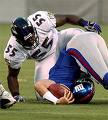
Terrell Suggs just signed a 6 year/$63 million deal with $31 million guaranteed, the second most guaranteed money in NFL history.
Although this happened on Wednesday or Thursday of last week, I still cannot get over the 6 year almost $63 million signed by Terrell Suggs. This contract made him the highest paid linebacker of all time. That is fine. Suggs has been a very productive player for 6 years and the outside linebacker/rush-end position is the most important position on a defense. As time goes on, contracts seem to increase as players and agents compare their worth to the players who signed a new contract before them. James Harrison signed a 6 year $51 million dollar contract this off-season after earning Defensive Player of the Year honors. It is only natural that contract discussions for a player of a similar caliber would start around that figure.
There are a few things I do not understand. First off is that the contract is so heavily front-loaded that it would have been cheaper to franchise Suggs next year. That is to say that he is slated to make $40 million of the total $63 million over his first 2 years, and this does is more expensive than if they franchised him next year which would likely have cost them less than the $20 million they will pay him next year. Not to mention his current contract would have been significantly less than the $20 million he will be owed this coming year. I understand locking Suggs up and freeing up cap room for future years by paying the majority of the contract early, I just think they spent far too much.
Terrell Suggs is supposed to make $63 million, $31 million of which is guaranteed. This is the second highest guaranteed total of all time. The only player to ever receive more guaranteed money is Peyton Manning, which is understandable. I love defense more than I like offense and as I said earlier, I believe the OLB/DE hybrid position to be the most important on defense, especially if this guy can play the run, which Suggs can. But the second highest guaranteed total ever? That means he has more guaranteed money that a long list of players who are more valuable to their team.
We will skip all of the offensive players who should make more guaranteed money than Suggs, like Tom Brady and Ben Roethlisberger, and just compare the value of other defensive players. Julius Peppers was unable to work out a long-term deal with the Panthers this off-season. Peppers is a defensive end and is paid to do the same things as Suggs, except that Peppers is the anchor of that defense. Yes Jon Beason is very good, but any quarterback and any offensive coordinator will tell you that the game plan is around Peppers. They know where the pressure is coming from and they still cannot stop it.
This is not the case with Terrell Suggs. Despite his talent at the most important position, Suggs is often thought of as the third best player on that vaunted Ravens defense. Ed Reed is on his way to becoming the best free safety of all-time. He is a ball-hawk who constantly makes quarterbacks pay for throwing the ball down field. Then there is Ray Lewis. Although Ray is aging, he is still proving to be a top 5 middle linebacker in the league every year. He remains in great shape, has a fantastic football IQ, and is the emotional leader of that defense. Although he is younger than the two aforementioned stars, Suggs does not seem to warrant more guaranteed money than either of them.
Although Suggs may not be the best defensive player on the Ravens, is he the most important? Importance is a difficult thing to rate and an often misjudged quality. However this is what teams are paying for, or at least what the pecking order should be under the salary cap. So how do we measure importance to determine if Suggs’ total is justified? Peppers’ importance was mentioned earlier and a more quantitative example of importance would be that of Troy Polamalu. When Polamalu does not play, the Steelers lose one third of their defensive playbook. Suggs has never been injured and thus this cannot be spoken for, however is Suggs that important to the Ravens?
The Ravens had 12 different players register a sack last season. Suggs led the way with 8 and Bart Scott has left for New York. So that means 10 other players accounted for the other 24 sacks. Normally I would say that this is an indication of Suggs’ presence on the field helping his teammates get to the quarterback. This could no doubt be true despite what I am saying. However the Ravens defense is known for being extremely aggressive. They usually blitz an additional two guys and their pressure usually results in a sack or Ed Reed running the other way with the football. The fact that 12 different guys register a sack and who knows how many QB pressures, is a testament to the fact that the Ravens could put many people into that defense and see good production. One third of their defensive play calling is not dependent on whether or not Terrell Suggs is playing. Opposing teams know six guys are coming and they are not sure where they are coming from.
Suggs, without a shadow of a doubt, is one of the most talented players in the league and the Ravens were right to lock him up with a long term deal. Did they overspend? Yes. They did not need to shell out $31 million guaranteed nor $40 million over the next two years. Most athletic linebackers could do a pretty good job in Suggs’ spot on that defense for a fraction of the cost.
Posted in Uncategorized
The end of the little big man?
Derrick Mason reportedly announced his retirement from professional football last night at age 35. This is despite back-to-back 1,000-yard seasons and a very promising young quarterback under center. Mason established himself with impeccable route-running, good quickness and great on-field awareness. He was one of the few small receivers who was able to be productive through intelligence and hard work. In today’s athletic world the guys getting drafted in the first round and dominating in the league today are guys who are well over six feet tall, like Andre Johnson, Larry Fitzgerald and Calvin Johnson. That type of height seems to almost be a prerequisite. This trend makes Mason’s accomplishments all the more impressive. Having said this, it has to make one wonder if the smaller receivers are a dying breed?
Due to the fact that athletes today are bigger and faster, not only would we expect the receivers to just be bigger but it would seem they would have to be in order to gain some sort of advantage over the defensive backs who seem to be coming into the league bigger and faster than ever before. Over the last three seasons 33 different players have caught 80 passes in a single season. Only nine of those players were under six-feet tall. One of those nine was Steve Smith, who does not play like the typical small receiver, and two of them, Brian Westbrook and Reggie Bush, are running backs. There are also a couple of receivers who were not their team’s number one target and thus did not garner most of the attention. Maybe even more notable is that it wasn’t until the third round of the ’09 draft that a team took a sub-six-foot pure receiver; that is, a player who only played receiver in college.
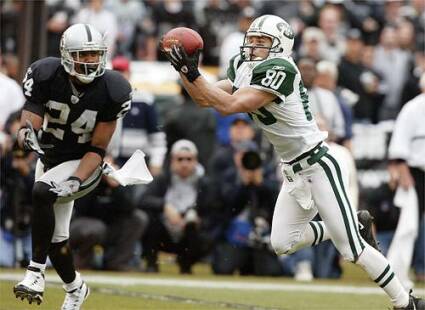
Are receivers like Wayne Chrebet going extinct?
Wes Welker has been extremely productive the last two seasons and this has to inspire hope amongst the younger, smaller receivers out there. This potential for smaller receivers to succeed is quite valid, however it comes with a few conditions. The first is that it is unlikely that a small possession receiver can be your number one guy. Eddie Royal caught 91 passes for almost 1,000 yards last year for Denver however it is clear that he benefited from all the attention that Brandon Marhsall demanded. Welker’s production has been aided by the presence of Randy Moss. If a smaller receiver got the attention of the shutdown corner or commanded a double team every snap they would not be as productive.
The second condition is that they can really only be valuable against zone coverage or when running short routes against man coverage. If they are smart they will be able to quickly find the holes in the zone and their quarterback can hopefully hit them in due time. If they are covered man-to-man they can prey off of their quickness as well as their knowledge of where they are supposed to go, but this advantage is very short-lived as the bigger and stronger defensive back can jam them at the line or catch up with them on a longer route.
The third condition is that they need a good quarterback. This sounds obvious and one could say that most receivers need a good quarterback. Smaller receivers need a smart qb who can quickly find them in the defense. The throw is going to have to be timely, strong and very accurate. If you’re a bigger, faster receiver, or Steve Smith, the throw does not have to be as accurate or as timely because you are likely bigger and faster than the man guarding you and can therefore win the battle on sheer physicality.
The final condition is that the small receiver needs the best set of hands. The throw is going to be in there quickly and the small receiver is going to get hit hard. Guys like Braylon Edwards and Terrell Owens can afford to drop more passes because they are always going to get balls thrown their way, as they are the bigger, faster, number one wide receiver. If you’re a small receiver and you drop a couple of passes it may be unlikely that you will see another ball thrown your way.
The little receiver does have a chance of survival and hopefully will not die out in the Darwinian National Football League. However it is very unlikely that a smaller receiver will be a productive number 1 guy, Steve Smith is the rare exception, not the rule. There is still hope for the smaller receiver so long as they run the best routes, have the best hands, and the best knowledge of the opposing defense. A good quarterback never hurts either.
Posted in Uncategorized
If the Human Torch Was Denied a Bank Loan…
Bank loans and sports are not an unlikely pairing. A family of four might take out a bank loan to afford the personal seat licenses on their season tickets. The NBA secured a line of credit for franchises that were reportedly losing between $15-$20 million annually (see Orlando Magic).
But never before have I’ve seen a pro sports team take out a bank loan to secure a free agent.
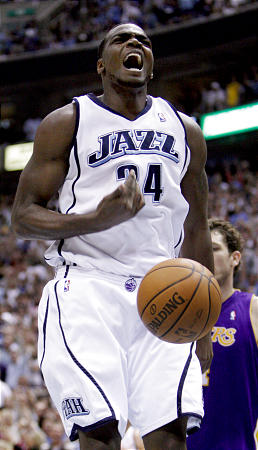
Feed me money
Until now. In an attempt to match the four-year $32 million offer sheet that Paul Milsap signed with the Portland Trailblazers last week, the Utah Jazz are reportedly seeking a $10.3 million loan.
The Jazz are not strapped for cash. But the parameters of the offer sheet are such that Milsap would receive a $5.6 million signing bonus and $4.7 million in first-year salary [$5.6 + $4.7=way too much money for an undersized power forward], and if the Jazz were to match, they would have to come up with those funds by Friday. Unlike the Blazers, whose owner Paul Allen is worth a recession-busting $10.5 billion, the Jazz are a small market team for whom $10 million cannot appear overnight.
There’s no doubt that the Blazers knew the Jazz would have trouble matching. With certain franchises losing money, it’d be bad business for franchises that are turning a profit to not take advantage.
But this monetary muscling only accelerates disparity in a league that is becoming increasingly top-heavy. The possibility that Dwayne Wade or LeBron James might change zip codes has every non-contender cutting payroll. Teams that are looking to win this year should be able to capitalize, but it’s looking like fiscal restrictions might narrow that championship-caliber caste even more.
From the small-market perspective, is the loan a future equalizer? For most teams, probably not. The days of low-interest rates are as gone as Ed McMahon, and most teams just can’t afford to pay a player and the bank for the same contract.
If you’re a Cleveland Cavaliers or a Los Angeles Lakers fan, this is great news. You might be able to sign a David Lee or a Raymond Felton on the cheap.
If you’re a Sacramento Kings or Milwaukee Bucks fan, well…There’s always next year.
Posted in Uncategorized
Tagged Free-Agency, Paul Milsap, Portland Trailblazers, Utah Jazz
Pace yourself, it’s a long night
With the Home Run Derby upon us newspapers and television shows are predicting who will win tonight in St. Louis. To me, more important than who will win, is how this player will win. In recent years we have seen many players blow up in the first or second round of the Derby, only to lose in the finals to a less conspicuous but more consistent opponent. Certainly everyone remembers Mark McGwire at Fenway in ’99 and Josh Hamilton last summer at Yankee Stadium each setting a record for home runs in a round. However, most people would probably have trouble citing the actual winners of both tournaments (Justin Morneau won last year; frankly I’m too lazy to look up who won in 1999).
This upsets a lot of baseball fans. Hamilton was definitely the crowd favorite to win it last summer after belting 28 in the first-round. A lot of critics say that the Hamiltons and McGwires are just trying their hardest to put on a show for the fans, and that when they do, they should be justly rewarded. While I understand this argument, the Derbies that contain a player who hits the most homers in the first two rounds often have very mundane and anti-climactic finishes.
The final round is head-to-head, mano-y-mano. It is meant to be an exciting duel to the finish between the day’s two top sluggers. While McGwire and Hamilton were exciting in the first round, both of them tired out in the following rounds. Both players hit the fewest home runs in each round after their big blowout. Hamilton only got into the finals because of his cumulative score which included his first-round total. Then he disappointed all of the fans cheering for him when he hit only three home runs in the final-round. McGwire didn’t even make it to the final round in ’99.
So is there something to be said for saving your energy for the finals? Absolutely! While the first rounds incorporate more players, the final-round, as in all sports, is supposed to be more exciting. When you watch Wimbledon each year, you want the highlight to be that epic five-set final, like the one between Roger Federer and Andy Roddick. I am sick of watching a Home Run Derby final involving one mediocre slugger beat the fan favorite who unfortunately, sprinted the first lap of the proverbial mile.
If I am a player who wants to win the Home Run Derby and put on a show for the fans I would pace myself, as I would if I were running a mile race.
Ideally, the Home Run Derby should be a sprint; all sluggers hitting as many dingers as possible in all rounds. However this has not proven to be how the event plays out. A player who hits a lot of homers in the first round usually gets tired both physically and mentally, and does not produce later on. So I think that players should hit mediocre amounts of home runs in the first couple of rounds and then light up the scoreboard in the finals. This way each player can establish a groove without tiring himself out. Obviously each player still has to ensure that he makes it to the next round, this is where the competition ensues.
I am in no way suggesting that a player dog it early on so that we see a pathetic first two rounds. Just that he pace himself as if he was running a mile. Jog meaningfully for 3.5 laps and then sprint until the finish.
Posted in Uncategorized
Home Run Derby: Why stop?
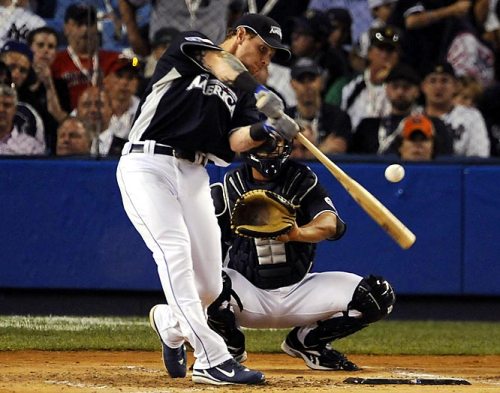
Anyone who watched the Home Run Derby last year remembers Josh Hamilton. Baseball’s comeback story of the year sent the old Yankee Stadium out in style as he used his heavily tattooed arms to lift home run after home run over the centerfield wall. What a lot of people don’t remember however, is that after Hamilton’s first-round outburst, he fizzled out, managing to hit only seven home runs over the last two rounds. While Hamilton’s mark on the home run derby may have been indelible in the court of public opinion, Justin Morneau is ultimately the one in the record books.
Thus the question has to be begged: Do you go for broke and hit as many home runs in a round as you can or do you leave a little in the tank so that can take home the trophy? In this writer’s humble opinion, the answer is easy–why lighten up?
Take Bobby Abreu for example. Known more for his ability to get on base than to knock the ball out of the park, Abreu blew the competition away in 2005 when he launched 24 first-round home runs (it doesn’t hurt when the competition is comprised of Hee-Seop Choi either). Like a freight-train heading downhill, Abreu never let up, winning the competition easily and tallying 41 total dingers; a record to this day. No doubt Abreu’s first round momentum helped carry him through.
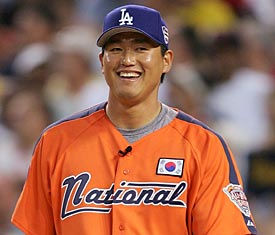
They must have been desperate
The format instituted in 2006 makes it even more advantageous for hitters to swing like there is no tomorrow. Starting in 2006, the players with the most home runs in the first two rounds advance to the championship round. A direct beneficiary being David Wright, whose 16 home run outburst in the first-round helped catapult him to the championship round. You strike while the iron is hot, because had Wright let up in the first-round, he may have been videotaping the Derby championship from the first-base line.
Lastly, you always hit as many balls out of the park as you can because who cares if you actually win the Derby. Take for example the latest commercial advertising the 2009 Derby. It features recent winners Ryan Howard and Vlad Guerrero, but not Morneau. In his place is that same tattooed basher who burnt himself out by hitting too many home runs in the first-round.
So while Hamilton didn’t bring home a trophy or win someone a house, he gave us all a memory we won’t forget anytime soon. And isn’t that what the all-star festivities are about anyways?
